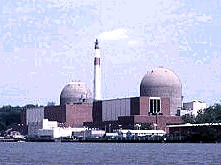For Immediate Release
February 10, 2009
Indian Point Environmental Impact Study Ignores Health Risks,
Environmental Justice Impacts and Benefits of Renewable Energy
 POUGHKEEPSIE, NY — Manna Jo Greene, environmental director at
Hudson River Sloop Clearwater, joined Joseph Mangano of the Radiation
and Public Health Project today at the U.S. Nuclear Regulatory
Commission (NRC) hearing in Cortlandt Manor, NY, in presenting newly
released data that shows that thyroid cancer rates in the four counties
closest to Indian Point are nearly double the U.S. average, and that
childhood cancer in these counties is also above the national rate.
POUGHKEEPSIE, NY — Manna Jo Greene, environmental director at
Hudson River Sloop Clearwater, joined Joseph Mangano of the Radiation
and Public Health Project today at the U.S. Nuclear Regulatory
Commission (NRC) hearing in Cortlandt Manor, NY, in presenting newly
released data that shows that thyroid cancer rates in the four counties
closest to Indian Point are nearly double the U.S. average, and that
childhood cancer in these counties is also above the national rate.
The NRC recently issued a Draft Supplemental Environmental Impact
Statement (DSEIS) on the relicensing of Indian Point nuclear reactors in
Westchester County, NY, and concluded that Indian Point poses no
significant public health risk. The statement is part of the federal
review for the application to extend the licenses for Indian Point Units
2 and 3 for 20 years.
Data just released by the New York State Health Department, however,
show that thyroid cancer rates in the four counties closest to Indian
Point are nearly double the U.S. average, and that childhood cancer
rates in these counties are also above the national rate. Rockland,
Orange, and Putnam Counties, three of the four counties flanking Indian
Point, had the 1st, 2nd, and 3rd highest thyroid cancer rates in
2001-2004 of all 62 New York State counties. The other county,
Westchester, had the 8th highest rate. A total of 992 persons in the
four counties were diagnosed with thyroid cancer in these four years.
In addition, a study by the Mother’s Milk Project shows that nearly all
of 30 milk samples from breastfeeding mothers and goats within 50 miles
of Indian Point reveal levels of strontium-90, with the highest results
occurring closest to the nuclear plant located on the Hudson River in
Buchanan, New York. Together with the NYS Health Department data, this
suggests that emissions from Indian Point may be compromising the health
of local residents.
The SDEIS also dismisses any disproportionate impacts on minority or low
income communities, including impacts on families of subsistence
fishermen who catch fish and crabs that contain traces of strontium-90
and other isotopes, as insignificant. In a previous generic environment
impact study (GEIS) done in 1996 for all nuclear power plants, the
health and environmental impacts were considered to be “small”. The
newly released SDEIS focuses on any additional impacts from planned
releases and discharges at Indian Point during normal operations and the
leaks of radioactive isotopes that were discovered in and are specific
to Indian Point.
Clearwater’s Environmental Director, Manna Jo Greene, notes, “While the
regulatory standards the NRC staff used to evaluate the radioactive
isotopes leaking from the plant into the Hudson may allow them to label
the potential impacts ‘small’ and ‘of no significant impact to plant
workers, the public and the environment’, we are not convinced. This
additional burden of radioactivity to people who may be catching and
eating fish, sharing their catch with friends and families without even
realizing that the plant is leaking radioactivity, is an example of
environmental injustice.”
The SDEIS also failed to consider the impacts on United Water of New
York’s proposed desalination plant in Haverstraw Bay, which, if
approved, would provide 7.5 million gallons a day of drinking water to
Rockland County.
Although the SDEIS does provide comparisons of renewable energy
resources to nuclear power generated Indian Point, it underestimates the
ability of energy efficiency and renewables to serve as more sustainable
alternatives to nuclear or fossil fuel. It ignores, for example,
Westchester County Executive Andy Spano’s aggressive plan to reduce the
county’s carbon footprint by 20 percent within the next seven years and
80 percent by 2050. Also, Stanford University’s Mark Z. Jacobson
recently conducted the first quantitative, scientific evaluation of
major, energy-related solutions currently extant, assessing not only
their energy potential but also their impacts on global warming, human
health, energy security, water supply, space requirements, wildlife,
water pollution, reliability and sustainability. Jacobson—who received
no funding from any interest group, company or government agency—ranked
nuclear and coal with capture and carbon sequestration tied for last
place as the two worst sources of energy. Best was wind, followed by
concentrated solar, geothermal, tidal, solar photovoltaics, wave and
hydroelectric.
In addition to minimizing concern in issues addressed in the SDEIS, most
of the public health safety and environmental issues, which the public
would assume are being considered, are deemed to be “out of the scope”
of the relicensing proceedings. For example, although the huge increase
in the surrounding population in the past 40 years is noted, the
corresponding impossibility of a viable evacuation plan is considered to
be out of scope, as are the plant’s vulnerability to terrorism in a
Contact:
Manna Jo Greene
Environmental Director
Hudson River Sloop Clearwater
845-807-1270
mannajo@clearwater.org